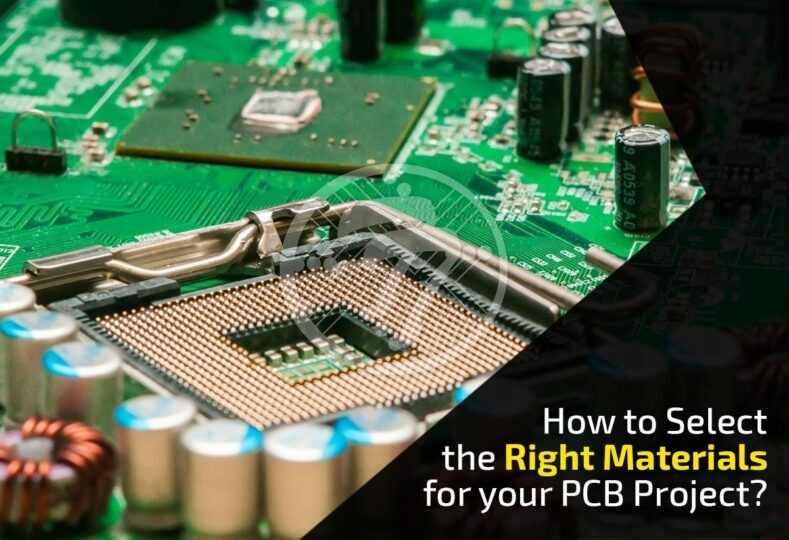PCB Material Selection Guide – How to Select the Right Materials for your PCB Manufacturing Project?

When you are manufacturing something as critical as a Printed Circuit Board that can determine the success or failure of a product, it goes without saying that the choice of material for the PCB is crucial. The PCB material needs to conform to quality standards while also being available at optimal costs.
Here are some factors to be considered in choosing the PCB materials:
Glass Transition Temperature (Tg)
Glass transition temperature, simply put, is the temperature at which the base material shifts from a glassy, solid, rigid state to a rubbery state.
If the PCB’s operating temperature exceeds its Tg for a prolonged period of time, the PCB will change from glassy state to rubbery state. This in turn will affect its performance.
It is, therefore, crucial to determine the temperature to which the PCB will be exposed, to be able to select the right materials with appropriate Glass Transition Temperature
Coefficient of Thermal Expansion (CTE)
The different materials that PCBs are made up of have different coefficients of thermal expansion. With temperature rising, it leads to expansion of material and can result in mechanical stress that can result in micro cracks that can go unnoticed and can even lead to failure of the final product. It is important therefore to choose substrate material with low Co-efficient of Thermal Expansion.
Electrical Performance
Another aspect to consider is the electrical performance. It is advised to go with PCB Material that has high dielectric constant and low dielectric loss. The other areas to look for include:
- Insulation resistance
- Dielectric Strength
- Arc Resistance
Flatness
PCB bending or warping can lead to a whole range of issues. It could be small so it is not noticed; on the other hand it could be so severe that it could cause immediate electrical issues. In choosing material for PCB, therefore, due emphasis needs to be laid on the fact that PCB typically requires warpage lower than 0.0075 mm/mm.
Specific industry or products
In addition, the choice of PCB material selection also depends upon the industry for which the PCB is being used and its specific requirements.
Electronic products typically require FR4 epoxy fiber glass substrate, as there isn’t any specific requirement, given the nature of the product with regard to flexibility or temperature. However, where there is a requirement for flexibility or temperature, it is recommended to use polyimide glass fiber substrate. For PCB where the requirement is one of thermal dissipation, a metal base substrate is recommended.
Types of PCB Substrate Material
Commonly used PCB substrate material includes Copper clad laminate or what is popularly known as CCL. In turn, CCL can be categorized as below:
Rigid CCL
This includes the following:
- Paper based Phenolic CCL
With its low cost, the use of this is ubiquitous. The consumer electronics, industry, particularly sees its wide spread use. - Paper-Based Epoxy CCL
This is largely used in through-hole PCB in the consumer electronics industry. - Paper-Based Polymer CCL
This kind of CCL finds extensive use in the Color TV and stereo industry, primarily on account of its anti-CAF characteristics. - Fiberglass Epoxy CCL
This is the most widely used CCL when it comes to telecommunications, medical care, CPU and more. The key characteristics that endear it to many industries include its:- Heat resistance
- Chemical resistance
- Dimensional stability
- Electric insulation and more
- Paper-Based Polymer CCL
This kind of CCL finds extensive use in the Color TV and stereo industry, primarily on account of its anti-CAF characteristics.
Composite CCL
This CCL is known to work well on single-sided and through-hole PCBs as also for SMT assembly on thin PCB boards. In addition CEM-3 composite CCL is also preferred on account of its:
- Moisture resistance
- Heat resistance
- Dimensional stability
In choosing PCB Material, another aspect that needs to be kept in mind is its Fire Resistance. It is therefore advisable to go for FR4 grade of material. FR4 in turn can be further subdivided into a number of classifications:
A1 – This is largely used in industries such as:
- Automobile
- Telecommunication
- Industrial instrument and more, on account of it being high on performance and durability
A2 – This finds application in:
- Home appliances
- Electronic Products
- PCs
This grade is known to be cost-efficient, which also explains its ubiquitous usage.
A3 – This grade is typically used in common electronic products such as:
- Toys and games
- Calculators and more
A3 is known for its extremely low price and compatibility with product functions.
A fair understanding of the above factors leads to usage of the right PCB material management, which in turn, is critical in the functioning of the PCB and in turn, of the final product.
Choosing the right PCB Manufacturer can go a long way in ensuring that there are no costly errors to pay for, as the product is ready for release.
Technotronix adopts advanced PCB production techniques and manufacturing practices with specialization in a varied range of PCB fabrication process, producing high quality multi-layered PCBs from tailor-made layouts. With over 40 years of combined experience in rendering high tech PCB assembly and manufacturing services, we are not just an assembler, we can completely test at board level to box build level to provide the benefit of unparalleled technical expertise and the most progressive solutions at competitive prices.
Know More About Our PCB Manufacturing Service.
For Any Kind of PCB Manufacturing Service, Request a Free Quote!






